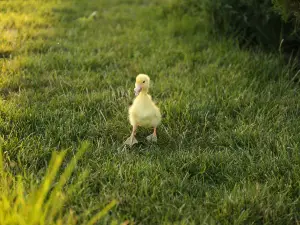
Duck feet are not like human feet. Unlike human feet, ducks have feet that are webbed together with skin, this webbing helps ducks swim better and is quite normal. What isn’t normal is curled feet in ducklings. This article looks into why this happens
Table of Contents
Duckling curled feet:
Curled feet in ducklings are an abnormality, this abnormality is called curly toe paralysis and can happen for a number of reasons. Here are possible reasons why this happens and what to do:
Injury while in the egg:
A duckling isn’t always positioned in its egg correctly, this can cause curly toe paralysis.
In addition, a bird may try to position itself differently before hatching, but the repositioning may not happen successfully, this can also cause the bird to hatch with curly toe paralysis.
What to do:
In some cases, the bird is able to stretch out its own foot and get it to sit normally, this usually happens in a day or so but this isn’t always the case.
If the bird can’t manage to straighten its foot on its own then you may need to do this by making a duck shoe for the bird.
How to make a duck shoe for the bird:
Spread your duckling’s foot out on a piece of cardboard. Trace around the bird’s foot to make the bottom of the shoe and then cut this piece of cardboard out.
Once the bottom of the shoe is ready, carefully spread the bird’s toes out and tape the toes to the cutout piece.
Let the bird walk around and live in these shoes for about 24-48 hours. Check the bird’s progress after this time to see if the feet sit normally on their own.
If the feet aren’t normal after this you can retape the shoes onto the bird’s feet
If you’d prefer to not make the shoe yourself you can give the duck a pair of birdy booties to wear. Birdy booties are premade duckling sandals that can be used to treat curly toe paralysis in affected birds.
Vitamin deficiency:
One of the other causes of curly toe paralysis in ducks is a vitamin deficiency, namely a vitamin B2 (riboflavin) deficiency.
If a duckling is deficient in vitamin B2 then the bird may have other symptoms apart from curly toe paralysis, other symptoms of a lack of vitamin B2 include slow growth and diarrhea.
A vitamin B2 deficiency can also develop in ducklings who were hatched by hens who had a vitamin B2 deficiency.
What to do:
Giving the bird a vitamin B2 supplement, until its feet go back to normal, is the cure for curly toe paralysis caused by a lack of vitamin B2.
You can also supplement your bird’s diet with nutrients like calcium, phosphorus, and manganese, as well as vitamins like vitamin E, vitamin K, and vitamin D3.
There are vitamin B supplements that you can add to your bird’s water to help treat this condition. Adding brewers yeast to the bird’s feed is also said to help
You may also need to treat the bird’s foot using physiotherapy by keeping the bird’s foot in a shoe as previously illustrated.
Incorrect incubator settings:
The incubator settings that your bird’s eggs are incubated in can also cause the bird to develop issues like curly toe paralysis.
If the incubator temperature settings that your bird’s eggs are incubated in are too high then the ducklings may hatch with curly toe paralysis.
At-home incubators have a higher chance of causing curly toe paralysis in ducklings. This is because at-home incubators aren’t as high-tech and aren’t as accurate as more advanced incubators used by large hatcheries
What to do:
If this is the cause of your bird’s curly toe paralysis then you can use the treatments explained in the above to treat your bird.
You’d also need to use a more advanced incubator for your next set of eggs.
If you cannot get a more advanced incubator you may need to keep a closer eye on the settings of the incubator you currently have to make sure that the incubator settings are correct all throughout the incubation process
FAQ:
Why won’t my duckling stand up?
If you notice other issues with your pet’s motion, if your duck has trouble standing up, then you may think that this is another leg-related issue, it may or may not be.
If your duck won’t stand up then it may have suffered an injury to its back, its neck its legs, or the animal may have a sort of muscle weakness preventing it from standing up
How can you tell if a baby duck is stressed?
A stressed baby duck will show signs of stress, signs of stress in a pet baby duck include a loss of appetite, depression, disinterest in normal routines, diarrhea, ruffled feathers, vomiting, sudden lameness, nausea, and lethargy.
If you enjoyed this article then you may also be interested in other chicken related articles. Here are some articles that you may be interested in: Wild Duck Limping, Hens Picking On Rooster, Duck Lethargic Not Eating, Duck Not Eating, How Do I Know If My Duck Is Dying

